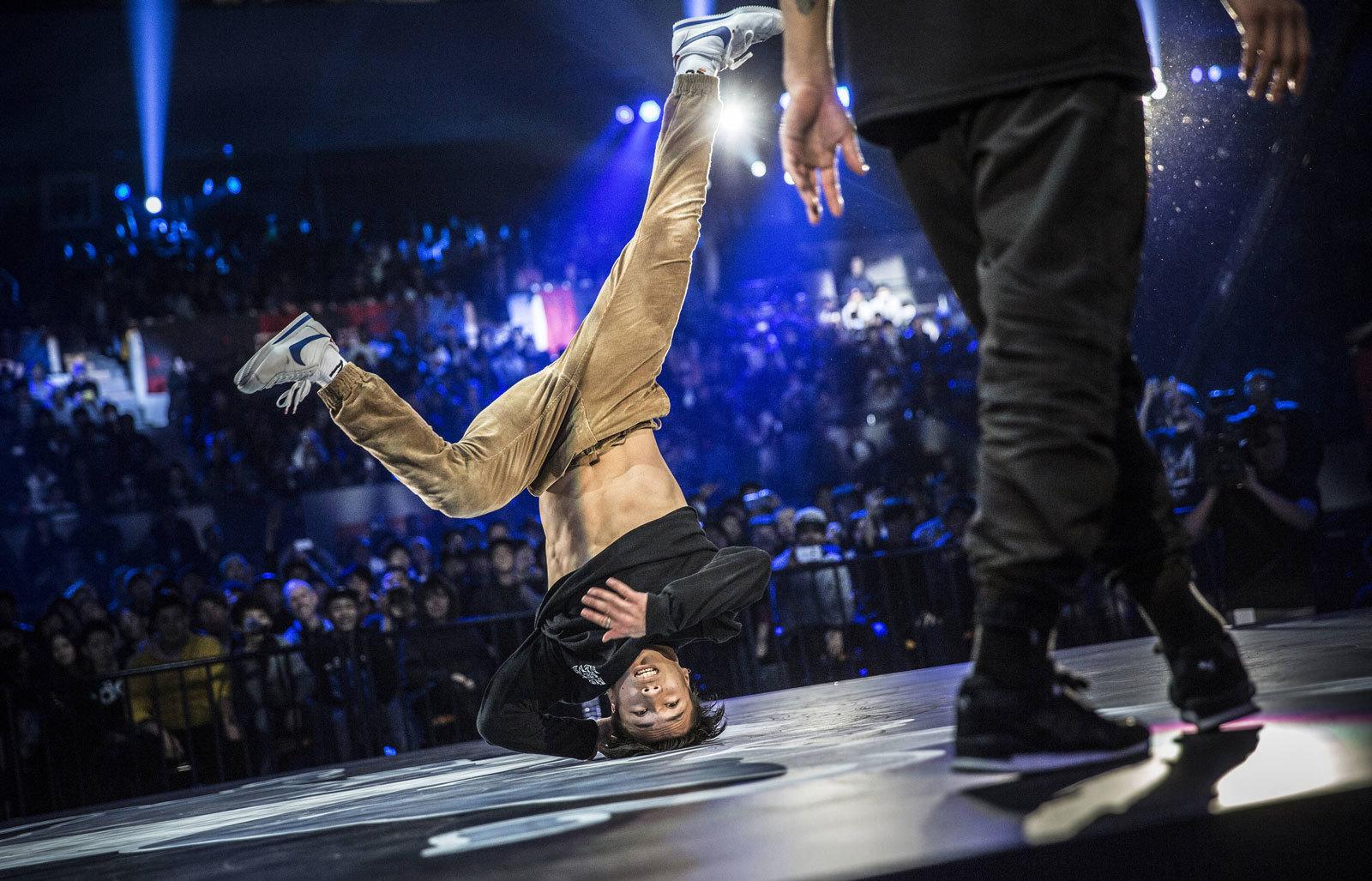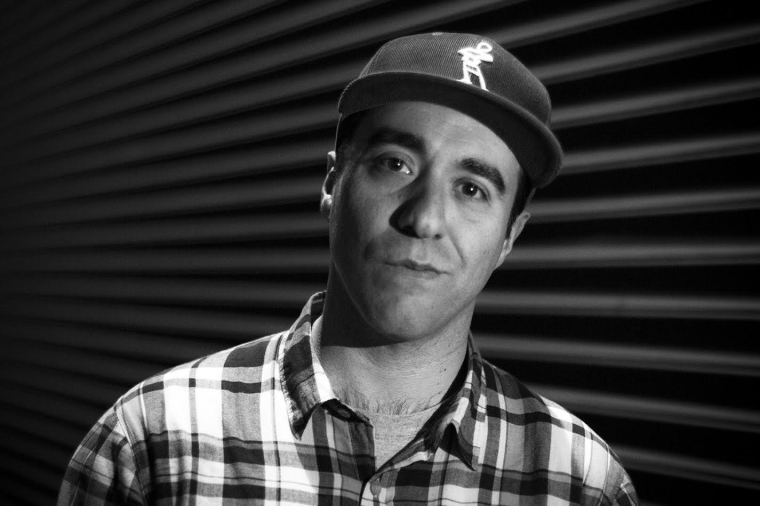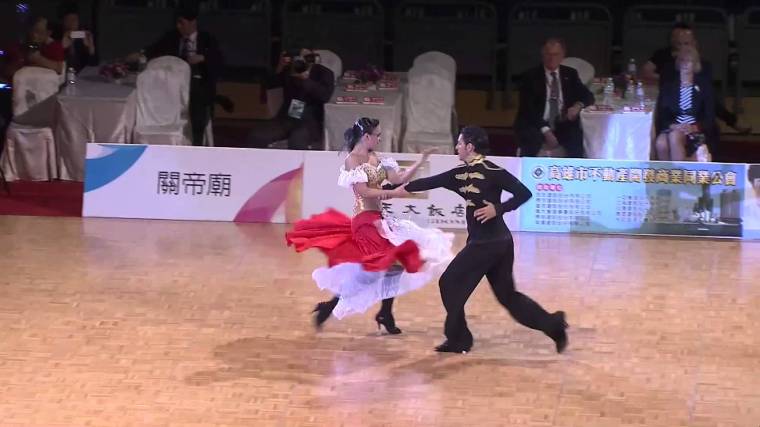This story was originally published on Dat Winning.
Flash back to the 2016 Red Bull BC One, the world’s biggest international one-on-one breaking competition, held in Nagoya, Japan. The finals featured a showdown between the old guard and the new. On one side, there was 19-year-old hometown favorite, B-Boy Issei; on the other, Hong 10, a competitor 14 years his elder.
Videos by VICE
After an exhausting five rounds in which each breaker (or b-boy) took turns demonstrating his musicality, while incorporating various acrobatics and taunts to the beats of DJ Mar Ski, it was Issei who earned the coveted championship.
The Red Bull BC One is one of the most prestigious and anticipated competitions in breaking, but it may find itself overshadowed as a premier event in 2018. Breaking has been named by the International Olympics Committee (IOC) as one of three new sports to be added to the 2018 Youth Olympics in Buenos Aires.
The announcement, which came four days after the conclusion of the BC One, was controversial. A petition quickly followed which alleged that the World DanceSport Federation (WDSF), the organization responsible for introducing breaking into the Olympics, was using the sport as a “Trojan horse” to get ballroom dancing into the Olympics.
This sets up a potential face-off between breaking and ballroom dancing, two dance forms that are polar opposites in style, substance and socioeconomic background.

Issei (left) performs against Hong 10 during the BC One World Final in Nagoya. Photo by Romina Amato/Red Bull Content Pool
Breaking is a form of street dance that originated among Puerto Rican and African American youth in the South Bronx neighborhood of New York City in the mid 1970s. It was considered one of the four pillars of hip hop culture, outlined by hip hop pioneer Afrika Bambaataa, along with turntablism (DJing), MCing (rapping) and aerosol art (graffiti).
Early practitioners of breaking were generally youth from the same kind of marginalized communities as the South Bronx, a stark contrast to ballroom dancing’s origins as a form of social dance for aristocrats.
Serouj “Midus” Aprahamian, a political activist and the b-boy who started the petition, is very aware of this fact. He also noticed that both the Washington Post and CNN used “breaking” in their articles, while the Olympic website used the term “dancesport.”
“I know what [dancesport] means, and I know that it means ballroom dancing,” he said. “So I started looking into this.”
Aprahamian believes the involvement of the World DanceSport Federation (WDSF) points to conceivably negative consequences, such as the sport being culturally misrepresented. He also questions whether money raised from potential sponsorship will be invested back into the breaking community.
“[They] pushed this through without consulting anybody in the breaking community–that’s unethical in any context,” says Aprahamian.
“The other [concern] is cultural. How is that going to be presented? People who have nothing to do with this dance are likely to misrepresent it. They’re calling it ‘breakdancing,’ which every breaker in the world knows is an artificial term that the media created. It’s indicative of the exploitation of the dance.”

Political activist and b-boy Serouj “Midus” Aprahamian. Photo by Ervin Arana
Roland Hilfiker, the Communications Director for the WDSF, denies the petition’s allegations of the WDSF being a ballroom dance organization and maintains that dancesport is a “generic brand for all kinds of styles of dance.”
On exploiting breaking, Hilfiker rejects the idea. “Everybody that has a little bit of foresight and knows how this works knows what’s happening,” he said.
“Breaking’s [participation] in the Olympic games will open up new horizons for what was to a certain extent a subculture up until now–not a subculture, but a limited-scale type thing.”
Hilfiker says this has precedent, pointing to the inclusion of snowboarding into the Winter Olympics under the International Ski Federation (ISF) in 1988, a move that similarly incited backlash from members of the snowboarding community.
“That was the only way that snowboarding could get into the Olympics, [by] an international federation recognized by the IOC,” he says.
Hilfiker maintains that breaking has been considered a discipline of dancesport since the 1990s. He also notes that breaking was one of the sports featured at the WDSF’s 2013 World DanceSport Games (WDSG) in Kaohsiung.
There is, however, no footage of any breaking competitions at the WDSG in any of the videos uploaded by various WDSF affiliated channels on YouTube, nor is breaking listed as an official category on the programme page for Kaohsiung. The only listing close to breaking was hip hop dance, but hip hop is a broader dance form that is generally separated from breaking in competition.
While the WDSF currently does not identify as a ballroom dance organization, the origins of the federation are certainly rooted in the medium.
In 1935, the WDSF was formed as the Federation Internationale de Danse pour Amateurs (FIDA) before being dissolved and reborn as the International Council of Dance Amateurs (ICAD) in 1956. In Ballroom: Culture and Costume in Competitive Dance (2008), Jonathan Marion, a ballroom dancer and Associate Professor of Anthropology at the University of Arkansas, lists FIDA and ICAD among the “prominent organizations that shaped the historical development of contemporary ballroom dancing.”
ICAD was once again rechristened as the International DanceSport Federation in 1990, before arriving at its current iteration as the WDSF in 2011. According to Marion, the change from ICAD to the IDSF was intended to “further the recognition of competitive ballroom dancing as a sport, especially amidst efforts to gain recognition from the International Olympic Committee” and referred to the then-IDSF as “the largest ballroom organization in the world.”
After the WDSF was successfully recognized by the IOC in 1997, the organization was unsuccessful in its attempts to get ballroom dancing into the 2008 and 2012 Olympics. Aprahamian’s petition implies by introducing breaking into the Youth Olympics, the WDSF will gain leverage in the future to achieve its original goal of pushing ballroom dance into the program.
Additionally, US Dance, the national governing body for the WDSF, was the United States Amateur Ballroom Dance Organization up until 2005. On its website, USA Dance bills itself as the “National Governing Body for DanceSport in the United States,” but its mission statement is to “improve the quality and quantity of ballroom dancing in the United States.”

Screengrab from a YouTube video of the Showdance Latin Final in the 2013 World DanceSport Games in Kaohsiung, Taiwan.
When the Olympics announcement was first made, the immediate reaction from the breaking community was not focused on whether its culture was being co-opted. This was due to an announcement by the United Breakin’ Association (UBA), a professional association with roughly 100 members, which stated it had been confidentially working with USA Dance and the WDSF toward the inclusion of breaking in the Olympics.
A week later, the UBA seemed to backtrack from its initial announcement with another statement that merely stated it was, “happy to be involved in the process of getting breakin’ into the Youth Olympics as part of a team of experts in the industry.”
While the WDSF did have a breaking task force for the Olympics games, Hilfiker says the UBA was not involved and that the members of the task force dismissed the UBA as, “a smallish organization that wants to up its profile by getting on the bandwagon.”
To some extent, Aprahamian agrees. He isn’t a part of the UBA, and doesn’t see them as a valid representation of the breaking community.
Hilfiker maintains that the executive director of the UBA, Ellen Zavian, was invited to join a WDSF task force called Other Dances, which was assembled to explore how national member organizations of the WDSF would conduct competitions in new dance styles. But he emphasizes it was an entirely unrelated matter.
“Ellen was definitely never, ever, a member of our Youth Olympic Games Task Force,” says Hilfiker.
Although the UBA does not currently have a working relationship with the WDSF, UBA president Candy Molia claims it did play a role in breaking’s inclusion in the Games. According to Molia, the UBA first reached out to USA Dance in 2014 about incorporating breaking into the Olympics. USA Dance did not respond until two years later, when officials asked the UBA for help in pitching breaking to the Youth Olympic committee.
“We know we were involved in helping prepare that pitch,” says Molia. “Whoever pitched it after that, they did a great job.”
When news began spreading that the UBA was less involved than originally thought, the breaking community found itself at an impasse. Miguel “Teck” Arteaga, a Chicago-based b-boy who heads his own media marketing company, confirms the community did not initially panic because of the UBA’s announcement.
“[The UBA] made an announcement saying that they have involvement with it, so a lot of people took that as ‘Oh they’re behind it, it’s okay we know some of those people,’” said Arteaga. “But [we] kind of found out they didn’t have any involvement, and now it’s something completely different.
“The breaking worldwide community doesn’t know the world dancesport organization exists, so that in itself is a big red flag.”
In the fallout of Aprahamian’s petition, Arteaga and Aprahamian have organized town hall meetings within their respective communities.
“After everything that transpired, we realized we need to be more organized within our own community,” says Arteaga. “It boils down to having to do something on a local level, because that’s the way that generally things like that work. There’s an international body, there’s a national governing body, and there’s a local governing body.”
The idea for forming a collective voice in the community was discussed long before the announcement of breaking in the Olympics, but Arteaga notes it was the Buenos Aires Games that catapulted the process.
According to Hilfiker, the WDSF has been reaching out to members of the community, and will soon announce the judges for the Youth Olympic games. Hilfiker promises the coming updates will take breaking “to the next level,” and “make history in many ways.”
Aprahamian claims, however, that breakers who have worked with the WDSF have yet to publicly announce their involvement with the rest of the community.
“I don’t understand why anyone would stay silent on it, nobody in the breaking community would chastise anybody for saying, ‘Hey, we’re involved in this.’ A lot of breakers would applaud this…it would alleviate their concerns,” said Aprahamian.
“But [they’re] staying silent, which is mind-boggling to me.”
Most Youth Olympics events are brought in from the Olympic Games, but breaking has yet to be added to the 2020 Games in Tokyo. This may indicate that the Buenos Aires games will serve as a testing ground for an event the IOC is not sure of yet. For the Tokyo Games, the IOC has focused on adding events that promote youth engagement, a criteria that breaking checks off.
If breaking is eventually added to the Olympics, it will mean greater exposure, which may bring an influx of new dancers looking for a pipeline to Olympic competition. It will also mean more established breakers may get to make a living from it. If the dance form becomes newly popularized, the question for its purists will be whether it can stay truthful to its roots. In Buenos Aires, this seems largely out of their hands, and the WDSF isn’t necessarily putting that idea to rest.
“[These changes] cannot be done by anybody else,” Hilfiker says. “Not this gentleman who started the petition, not by the people in this UBA, or any of the other professional organizations like Red Bull or anyone. This can only be done by an international, recognized, sponsored organization, which is, in this case, the WDSF.”
Want to read more stories like this from VICE Sports? Subscribe to our daily newsletter.




